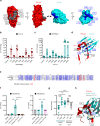Human CEACAM1 is targeted by a Streptococcus pyogenes adhesin implicated in puerperal sepsis pathogenesis
- PMID: 37080973
- PMCID: PMC10119177
- DOI: 10.1038/s41467-023-37732-1
Human CEACAM1 is targeted by a Streptococcus pyogenes adhesin implicated in puerperal sepsis pathogenesis
Erratum in
-
Author Correction: Human CEACAM1 is targeted by a Streptococcus pyogenes adhesin implicated in puerperal sepsis pathogenesis.Nat Commun. 2023 May 9;14(1):2675. doi: 10.1038/s41467-023-38372-1. Nat Commun. 2023. PMID: 37160921 Free PMC article. No abstract available.
Abstract
Life-threatening bacterial infections in women after childbirth, known as puerperal sepsis, resulted in classical epidemics and remain a global health problem. While outbreaks of puerperal sepsis have been ascribed to Streptococcus pyogenes, little is known about disease mechanisms. Here, we show that the bacterial R28 protein, which is epidemiologically associated with outbreaks of puerperal sepsis, specifically targets the human receptor CEACAM1. This interaction triggers events that would favor the development of puerperal sepsis, including adhesion to cervical cells, suppression of epithelial wound repair and subversion of innate immune responses. High-resolution structural analysis showed that an R28 domain with IgI3-like fold binds to the N-terminal domain of CEACAM1. Together, these findings demonstrate that a single adhesin-receptor interaction can drive the pathogenesis of bacterial sepsis and provide molecular insights into the pathogenesis of one of the most important infectious diseases in medical history.
© 2023. The Author(s).
Conflict of interest statement
The authors declare no competing interests.
Figures






Similar articles
-
Nosocomial outbreak of Streptococcus pyogenes puerperal sepsis.Clin Microbiol Infect. 2019 Apr;25(4):521-523. doi: 10.1016/j.cmi.2018.11.028. Epub 2018 Dec 27. Clin Microbiol Infect. 2019. PMID: 30593861 No abstract available.
-
A Mobile Genetic Element Promotes the Association Between Serotype M28 Group A Streptococcus Isolates and Cases of Puerperal Sepsis.J Infect Dis. 2019 Jul 31;220(5):882-891. doi: 10.1093/infdis/jiz195. J Infect Dis. 2019. PMID: 31107945 Free PMC article.
-
Analysis of a Streptococcus pyogenes puerperal sepsis cluster by use of whole-genome sequencing.J Clin Microbiol. 2012 Jul;50(7):2224-8. doi: 10.1128/JCM.00675-12. Epub 2012 Apr 18. J Clin Microbiol. 2012. PMID: 22518858 Free PMC article.
-
Puerperal group A streptococcal infection: beyond Semmelweis.Obstet Gynecol. 2014 Apr;123(4):874-82. doi: 10.1097/AOG.0000000000000175. Obstet Gynecol. 2014. PMID: 24785617 Review.
-
Pregnancy-related group a streptococcal infections: temporal relationships between bacterial acquisition, infection onset, clinical findings, and outcome.Clin Infect Dis. 2013 Sep;57(6):870-6. doi: 10.1093/cid/cit282. Epub 2013 May 3. Clin Infect Dis. 2013. PMID: 23645851 Free PMC article. Review.
Cited by
-
Integrated Analysis Identified TGFBI as a Biomarker of Disease Severity and Prognosis Correlated with Immune Infiltrates in Patients with Sepsis.J Inflamm Res. 2024 Apr 15;17:2285-2298. doi: 10.2147/JIR.S456132. eCollection 2024. J Inflamm Res. 2024. PMID: 38645878 Free PMC article.
-
Exploring the evolutionary and pathogenic role of Acinetobacter baumannii biofilm-associated protein (Bap) through in silico structural modeling.Arch Microbiol. 2024 May 18;206(6):267. doi: 10.1007/s00203-024-03992-8. Arch Microbiol. 2024. PMID: 38762620
-
Carcinoembryonic antigen-related cell adhesion molecule 1 in cancer: Blessing or curse?Eur J Clin Invest. 2024 Dec;54 Suppl 2(Suppl 2):e14337. doi: 10.1111/eci.14337. Epub 2024 Oct 25. Eur J Clin Invest. 2024. PMID: 39451132 Free PMC article. Review.
-
The role of carcinoembryonic antigen-related cell adhesion molecule 1 in cancer.Front Immunol. 2023 Nov 24;14:1295232. doi: 10.3389/fimmu.2023.1295232. eCollection 2023. Front Immunol. 2023. PMID: 38077351 Free PMC article. Review.
-
LncRNA 220: A Novel Long Non-Coding RNA Regulates Autophagy and Apoptosis in Kupffer Cells via the miR-5101/PI3K/AKT/mTOR Axis in LPS-Induced Endotoxemic Liver Injury in Mice.Int J Mol Sci. 2023 Jul 7;24(13):11210. doi: 10.3390/ijms241311210. Int J Mol Sci. 2023. PMID: 37446388 Free PMC article.
References
-
- Holmes, O. The contagiousness of puerperal fever. New Engl. Quart. J. Med.1, 503–530 (1843).
-
- Semmelweis, I. P. Die Aetiologie, der Begriff und die Prophylaxis des Kindbettfiebers, 1861. (University of Wisconsin Press, 1983).
Publication types
MeSH terms
Substances
Grants and funding
LinkOut - more resources
Full Text Sources
Medical
Miscellaneous

